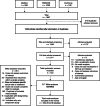Neutrophil to lymphocyte ratio and cancer prognosis: an umbrella review of systematic reviews and meta-analyses of observational studies
- PMID: 33213430
- PMCID: PMC7678319
- DOI: 10.1186/s12916-020-01817-1
Neutrophil to lymphocyte ratio and cancer prognosis: an umbrella review of systematic reviews and meta-analyses of observational studies
Abstract
Background: Although neutrophils have been linked to the progression of cancer, uncertainty exists around their association with cancer outcomes, depending on the site, outcome and treatments considered. We aimed to evaluate the strength and validity of evidence on the association between either the neutrophil to lymphocyte ratio (NLR) or tumour-associated neutrophils (TAN) and cancer prognosis.
Methods: We searched MEDLINE, Embase and Cochrane Database of Systematic Reviews from inception to 29 May 2020 for systematic reviews and meta-analyses of observational studies on neutrophil counts (here NLR or TAN) and specific cancer outcomes related to disease progression or survival. The available evidence was graded as strong, highly suggestive, suggestive, weak or uncertain through the application of pre-set GRADE criteria.
Results: A total of 204 meta-analyses from 86 studies investigating the association between either NLR or TAN and cancer outcomes met the criteria for inclusion. All but one meta-analyses found a hazard ratio (HR) which increased risk (HR > 1). We did not find sufficient meta-analyses to evaluate TAN and cancer outcomes (N = 9). When assessed for magnitude of effect, significance and bias related to heterogeneity and small study effects, 18 (9%) associations between NLR and outcomes in composite cancer endpoints (combined analysis), cancers treated with immunotherapy and some site specific cancers (urinary, nasopharyngeal, gastric, breast, endometrial, soft tissue sarcoma and hepatocellular cancers) were supported by strong evidence.
Conclusion: In total, 60 (29%) meta-analyses presented strong or highly suggestive evidence. Although the NLR and TAN hold clinical promise in their association with poor cancer prognosis, further research is required to provide robust evidence, assess causality and test clinical utility.
Trial registration: PROSPERO CRD42017069131 .
Keywords: Cancer; Neutrophil to lymphocyte ratio; Neutrophils; Prognosis; Tumour-associated neutrophils; Umbrella review.
Conflict of interest statement
The authors declare that they have no competing interests.
Figures


Similar articles
-
Revisiting the association between pretreatment thrombocytosis and cancer survival outcomes: an umbrella review of meta-analyses.BMC Cancer. 2024 Oct 9;24(1):1246. doi: 10.1186/s12885-024-13027-6. BMC Cancer. 2024. PMID: 39385116 Free PMC article.
-
Association of pretreatment neutrophil-to-lymphocyte ratio with clinical outcomes in cancer immunotherapy: An evidence synthesis from 30 meta-analyses.Int Immunopharmacol. 2024 May 10;132:111936. doi: 10.1016/j.intimp.2024.111936. Epub 2024 Apr 4. Int Immunopharmacol. 2024. PMID: 38579566
-
Folic acid supplementation and malaria susceptibility and severity among people taking antifolate antimalarial drugs in endemic areas.Cochrane Database Syst Rev. 2022 Feb 1;2(2022):CD014217. doi: 10.1002/14651858.CD014217. Cochrane Database Syst Rev. 2022. PMID: 36321557 Free PMC article.
-
The prognostic utility of pre-treatment neutrophil-to-lymphocyte-ratio (NLR) in colorectal cancer: A systematic review and meta-analysis.Cancer Med. 2021 Sep;10(17):5983-5997. doi: 10.1002/cam4.4143. Epub 2021 Jul 26. Cancer Med. 2021. PMID: 34308567 Free PMC article.
-
Prognostic role of neutrophil-to-lymphocyte ratio (NLR) in urological tumors: an umbrella review of evidence from systematic reviews and meta-analyses.Acta Oncol. 2021 Jun;60(6):704-713. doi: 10.1080/0284186X.2021.1886323. Epub 2021 Feb 15. Acta Oncol. 2021. PMID: 33586577
Cited by
-
Albumin and Neutrophil-to-Lymphocyte Ratio Score in Neoadjuvant Concurrent Chemoradiotherapy for Esophageal Cancer: Comparison With Prognostic Nutritional Index.In Vivo. 2022 Sep-Oct;36(5):2400-2408. doi: 10.21873/invivo.12973. In Vivo. 2022. PMID: 36099141 Free PMC article.
-
High Neutrophil-to-Lymphocyte Ratio Facilitates Cancer Growth-Currently Marketed Drugs Tadalafil, Isotretinoin, Colchicine, and Omega-3 to Reduce It: The TICO Regimen.Cancers (Basel). 2022 Oct 10;14(19):4965. doi: 10.3390/cancers14194965. Cancers (Basel). 2022. PMID: 36230888 Free PMC article.
-
The prognostic and clinical value of neutrophil-to-lymphocyte ratio (NLR) in ovarian cancer: A systematic review and meta-analysis.J Med Biochem. 2024 Jun 15;43(4):323-333. doi: 10.5937/jomb0-46035. J Med Biochem. 2024. PMID: 39139167 Free PMC article.
-
Immune cell-lipoprotein imbalance as a marker for early diagnosis of non-small cell lung cancer metastasis.Front Oncol. 2022 Oct 24;12:942964. doi: 10.3389/fonc.2022.942964. eCollection 2022. Front Oncol. 2022. PMID: 36353553 Free PMC article.
-
Predictive effect of systemic immune inflammatory index combined with neutrophil-to-lymphocyte ratio on prognosis of patients with acute-on-chronic liver failure.Am J Transl Res. 2023 Dec 15;15(12):6841-6848. eCollection 2023. Am J Transl Res. 2023. PMID: 38186984 Free PMC article.
References
-
- Collaboration GB of DC Global, regional, and national cancer incidence, mortality, years of life lost, years lived with disability, and disability-adjusted life-years for 32 cancer groups, 1990 to 2015: a systematic analysis for the global burden of disease study. JAMA Oncol. 2017;3(4):524–548. doi: 10.1001/jamaoncol.2016.5688. - DOI - PMC - PubMed
Publication types
MeSH terms
Grants and funding
LinkOut - more resources
Full Text Sources
Medical
Miscellaneous

